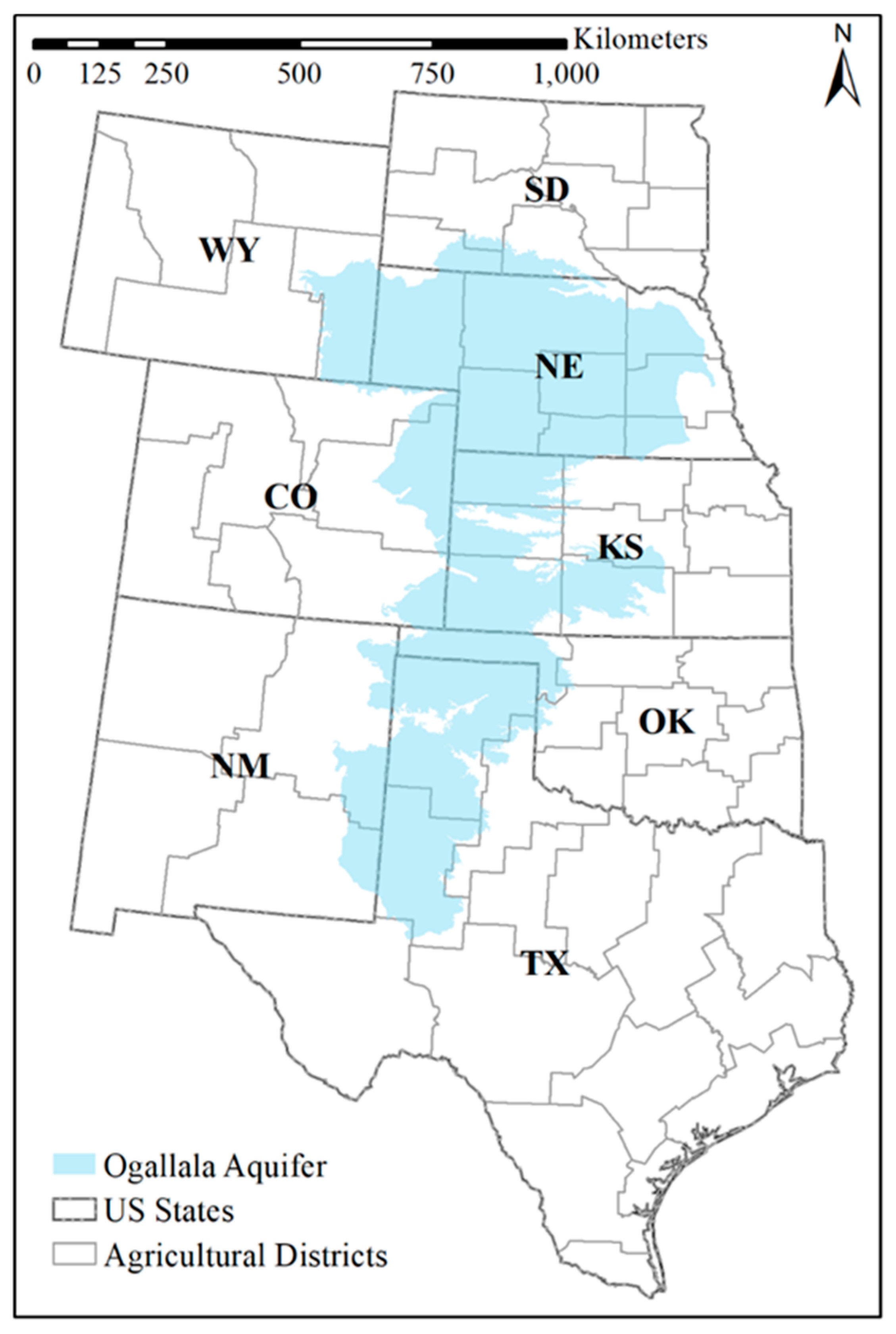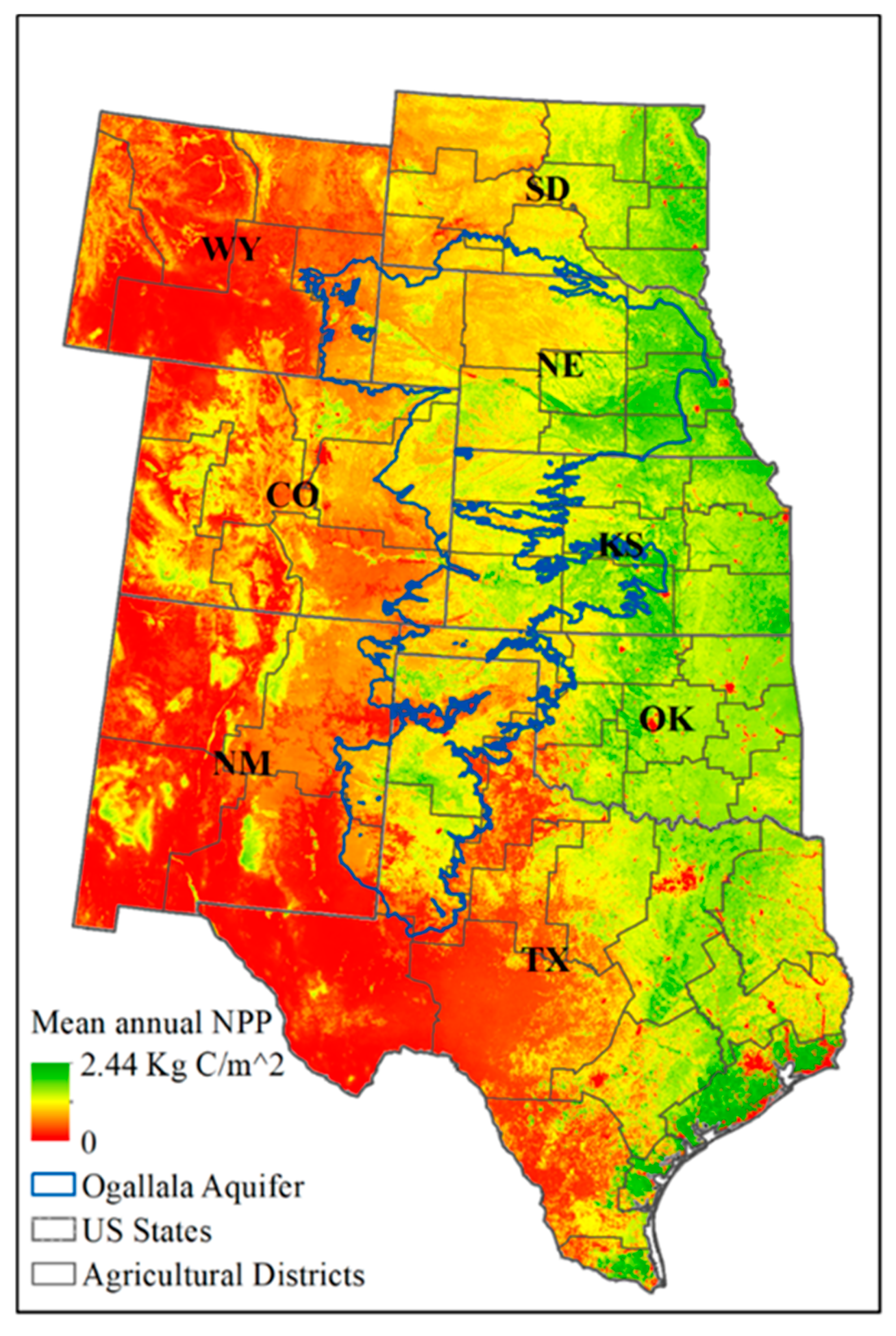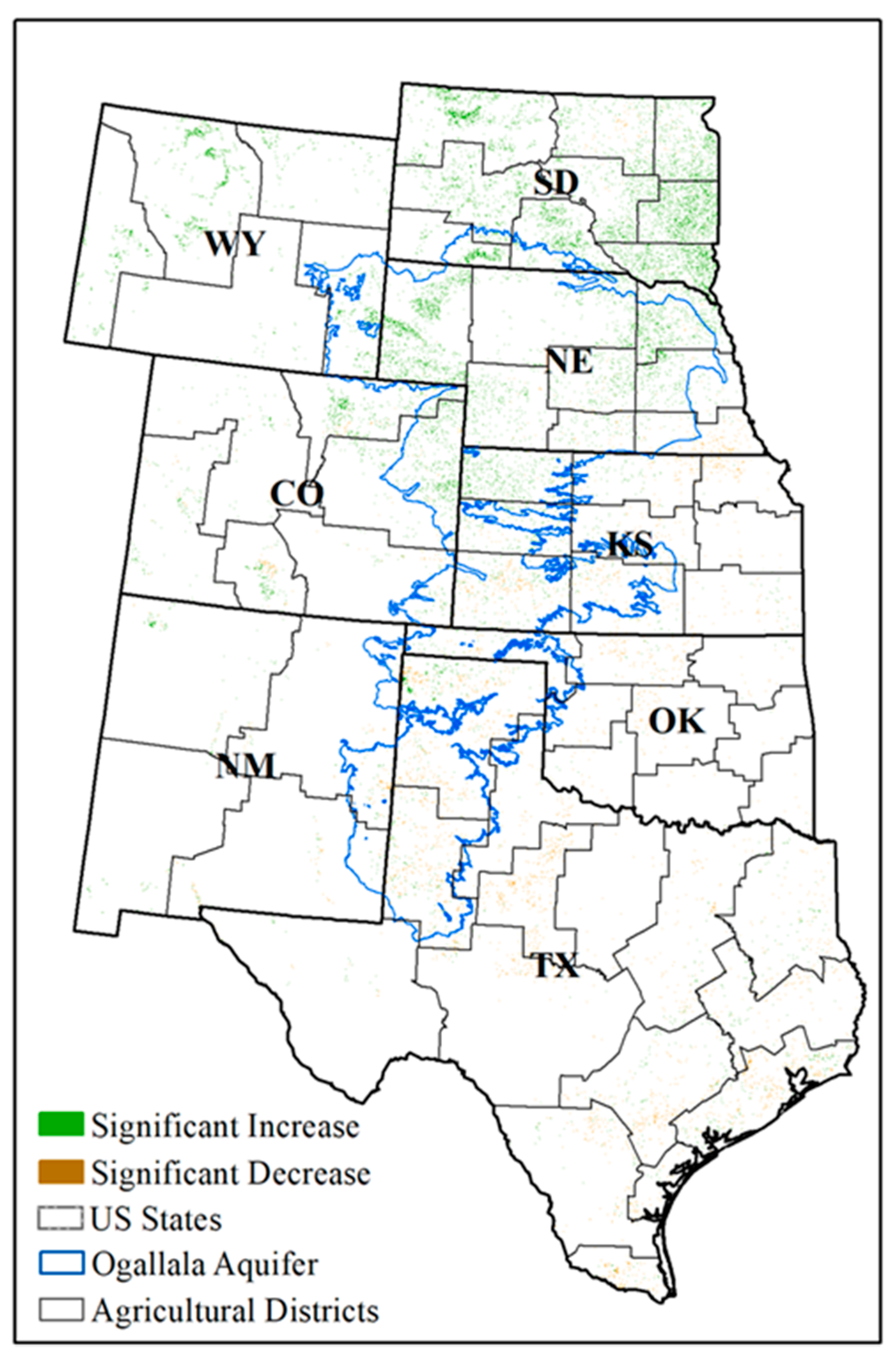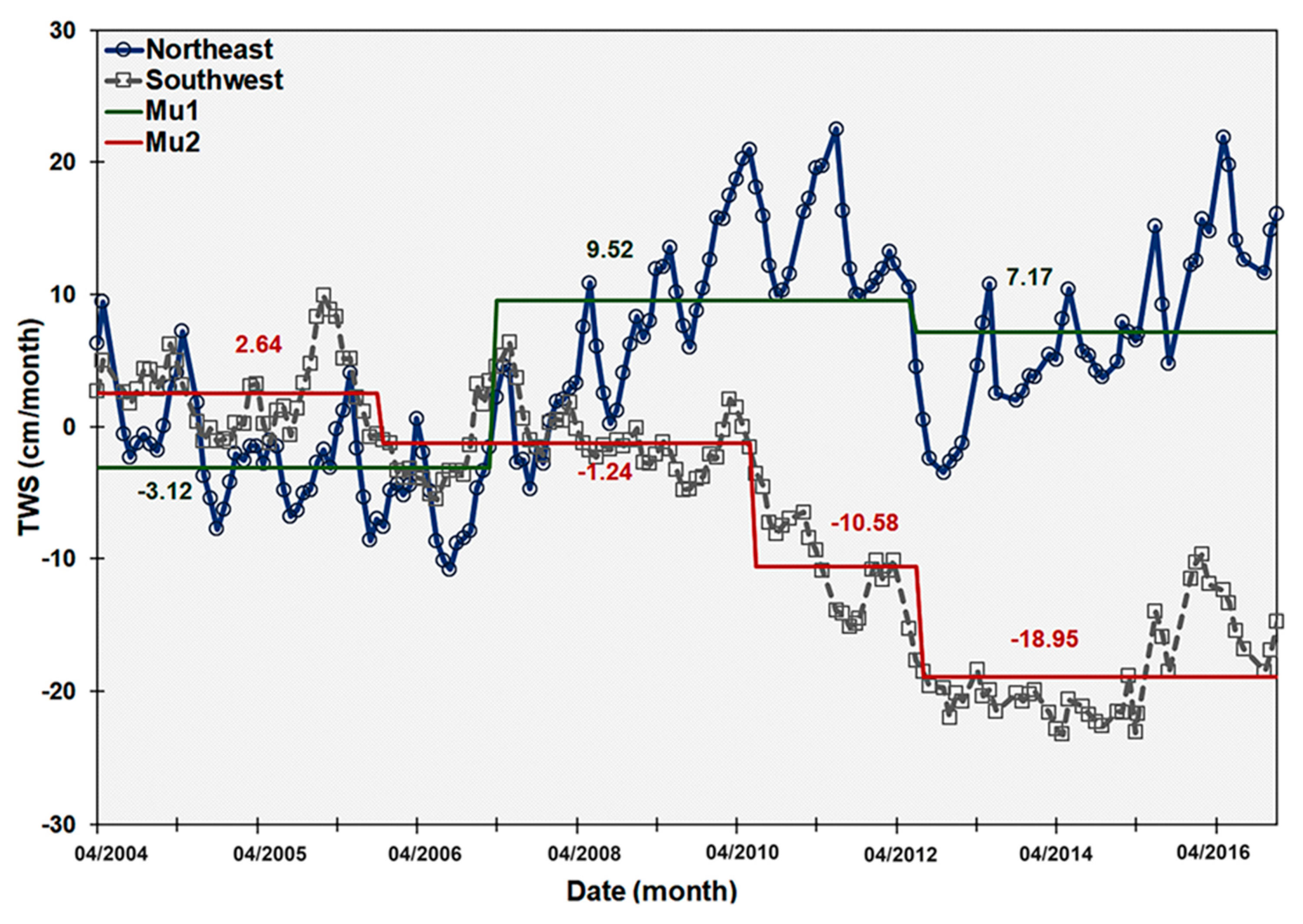Inspecting the Food–Water Nexus in the Ogallala Aquifer Region Using Satellite Remote Sensing Time Series
Abstract
1. Introduction
2. Location and Methods
2.1. Study Area

2.2. Climate Data
2.3. Moderate-Resolution Imaging Spectroradiometer (MODIS) for Net Primary Production (NPP)
2.4. Gravity Recovery and Climate Experiment (GRACE) and Total Water Storage (TWS)
2.5. Agricultural Statistics Data from the USDA National Agricultural Statistics Service
2.6. Trend Analysis of NPP, TWS, and LWC
3. Results and Discussion
3.1. Precipitation and Temperature Regimes from Long-Term Climate Data
3.2. Mean and Trend of Net Primary Production (NPP) during 2001–2018
3.3. Mean and Trend of Total Water Storage (TWS) during 2002–2017 and 2018–2020
4. Conclusions
- The relationships between declining water tables and subsequent increases in energy required to pump water from lower depths.
- The linkage between energy and water for corn grown as a biofuel.
- Use of nighttime light images to explore the connections between oil and gas activities and groundwater abstraction or injection.
Author Contributions
Funding
Acknowledgments
Conflicts of Interest
References
- Simpson, G.B.; Jewitt, G.P.W. The Development of the Water-Energy-Food Nexus as a Framework for Achieving Resource Security: A review. Front. Environ. Sci. 2019, 7, 8. [Google Scholar] [CrossRef]
- D’Odorico, P.; Davis, K.F.; Rosa, L.; Carr, J.A.; Chiarelli, D.; Dell’Angelo, J.; Gephart, J.; MacDonald, G.K.; Seekell, D.A.; Suweis, S.; et al. The Global Food-Energy-Water Nexus. Rev. Geophys. 2018, 56, 456–531. [Google Scholar] [CrossRef]
- Sophocleous, M. Groundwater recharge and sustainability in the High Plains aquifer in Kansas, USA. Hydrogeol. J. 2005, 13, 351–365. [Google Scholar] [CrossRef]
- Dennehy, K.F.; Litke, D.W.; McMahon, P.B. The High Plains Aquifer, USA: Groundwater development and sustainability. In Sustainable Groundwater Development; Hiscock, K.M., Rivett, M.O., Davison, R.M., Eds.; Geological Society, Special Publications: London, UK, 2002; Volume 193, pp. 99–119. [Google Scholar]
- Boryan, C.; Yang, Z.; Mueller, R.; Craig, M. Monitoring US agriculture: The US department of agriculture, national agricultural statistics service Cropland Data Layer Program. Geocarto Int. 2011, 26, 341–358. [Google Scholar] [CrossRef]
- Zhao, M.; Heinsch, F.A.; Nemani, R.R.; Running, S.W. Improvements of the MODIS terrestrial gross and net primary production global data set. Remote Sens. Environ. 2005, 95, 164–176. [Google Scholar] [CrossRef]
- Xie, Y.; Weng, Q. World energy consumption pattern as revealed by DMSP-OLS nighttime light imagery. GIScience Remote Sens. 2016, 53, 265–282. [Google Scholar] [CrossRef]
- Jasiński, T. Modeling electricity consumption using nighttime light images and artificial neural networks. Energy 2019, 179, 831–842. [Google Scholar] [CrossRef]
- Lu, L.; Weng, Q.; Xie, Y.; Guo, H.; Li, Q. An assessment of global electric power consumption using the Defense Meteorological Satellite Program-Operational Linescan System nighttime light imagery. Energy 2019, 189, 116351. [Google Scholar] [CrossRef]
- Pekel, J.-A.; Cottam, A.; Gorelick, N.; Belward, A.S. High-resolution mapping of global surface water and its long-term changes. Nature 2016, 540, 418–422. [Google Scholar] [CrossRef]
- Swenson, S.; Wahr, J.; Milly, P.C.D. Estimated accuracies of regional water storage variations inferred from the Gravity Recovery and Climate Experiment (GRACE). Water Resour. Res. 2003, 39, 1223. [Google Scholar] [CrossRef]
- Rodell, M.; Velicogna, I.; Famiglietti, J.S. Satellite-based estimates of groundwater depletion in India. Nature 2009, 460, 999–1002. [Google Scholar] [CrossRef]
- Famiglietti, J.S. The global groundwater crisis. Nat. Clim. Chang. 2014, 4, 945–948. [Google Scholar] [CrossRef]
- Rodell, M.; Famiglietti, J.S.; Wiese, D.N.; Reager, J.T.; Beaudoing, H.K.; Landerer, F.W.; Lo, M.-H. Emerging trends in global freshwater availability. Nature 2018, 557, 651–659. [Google Scholar] [CrossRef] [PubMed]
- Koppa, A.; Gebremichael, M. Improving the Applicability of Hydrologic Models for Food-Energy-Water Nexus Studies Using Remote Sensing Data. Remote Sens. 2020, 12, 599. [Google Scholar] [CrossRef]
- Sanders, K.T.; Masri, S.F. The energy-water agriculture nexus: The past present and future of holistic resource management via remote sensing technologies. J. Clean. Prod. 2016, 117, 73–88. [Google Scholar] [CrossRef]
- Alam, S.; Gebremichael, M.; Li, R. Remote Sensing-Based Assessment of the Crop, Energy and Water Nexus in the Central Valley, California. Remote Sens. 2019, 11, 1701. [Google Scholar] [CrossRef]
- USDA National Agricultural Economic Research Service. Available online: https://www.ers.usda.gov/topics/farm-practices-management/irrigation-water-use/#importance (accessed on 27 May 2020).
- Houston, N.A.; Gonzales-Bradford, S.L.; Flynn, A.T.; Qi, S.L.; Peterson, S.M.; Stanton, J.S.; Ryter, D.W.; Sohl, T.L.; Senay, G.B. Geodatabase Compilation of Hydrogeologic, Remote Sensing, and Water-Budget-Component Data for the High Plains Aquifer 2011; U.S. Geological Survey Data Series; USGS: Reston, VA, USA, 2013; Volume 777, p. 12.
- USDA National Agricultural Statistics Service. Available online: http://www.nass.usda.gov (accessed on 29 May 2020).
- Stanton, J.S.; Qi, S.L.; Ryter, D.W.; Houston, S.E.; Peterson, N.A.; Westenbroek, S.M.; Christenson, S.C. Selected Approaches to Estimate Water-Budget Components of the High Plains, 1940 through 1949 and 2000 through 2009; U.S. Geological Survey Scientific Investigations Report 2011-5183; USGS: Reston, VA, USA, 2011; p. 79.
- Sophocleous, M. Review: Groundwater management practices, challenges, and innovation in the High Plains Aquifer, USA—Lessons and recommended actions. Hydrogeol. J. 2010, 18, 559–575. [Google Scholar] [CrossRef]
- Qi, S.L. Digital Map of the Aquifer Boundary of the High Plains Aquifer in Parts of Colorado, Kansas, Nebraska, New Mexico, Oklahoma, South Dakota, Texas, and Wyoming; U.S Geological Survey Data Series 543; USGS: Reston, VA, USA, 2010.
- PRISM Climate Group, Oregon State University. Available online: http://prism.oregonstate.edu (accessed on 4 January 2020).
- Schowalter, T.D. Insect Ecology: An Ecosystem Approach, 4th ed.; Academic Press: London, UK, 2016; p. 774. [Google Scholar]
- Tao, F.; Yokozawa, M.; Zhang, Z.; Xu, Y.; Hayashi, Y. Remote sensing of crop production in China by production efficiency models: Models, comparisons, estimates and uncertainties. Ecol. Model. 2005, 183, 385–396. [Google Scholar] [CrossRef]
- Prince, S.D.; Haskett, J.; Steininger, M.; Wright, R. Net Primary Production of U.S. Midwest Croplands from Agricultural Harvest Yield Data. Ecol. Appl. 2001, 11, 1194–1205. [Google Scholar] [CrossRef]
- Zhao, F.; Xu, B.; Yang, X.; Jin, Y.; Li, J.; Xia, L.; Chen, S.; Ma, H. Remote Sensing Estimates of Grassland Aboveground Biomass Based on MODIS Net Primary Productivity (NPP): A Case Study in the Xilingol Grassland of Northern China. Remote Sens. 2014, 6, 5368–5386. [Google Scholar] [CrossRef]
- Reeves, M.C.; Winslow, J.C.; Running, S.W. Mapping Weekly Rangeland Vegetation Productivity Using MODIS Algorithms. J. Range Manag. 2001, 54, A90–A105. [Google Scholar]
- Jenkins, J.C.; Birdsey, R.A.; Pan, Y. Biomass and NPP Estimation for the Mid-Atlantic Region (USA) using plot-level forest inventory data. Ecol. Appl. 2001, 11, 1174–1193. [Google Scholar] [CrossRef]
- Chapin, F.S., III; Matson, P.A.; Vitousek, P.M. Principles of Terrestrial Ecosystem Ecology, 2nd ed.; Springer: New York, NY, USA, 2011; p. 529. [Google Scholar]
- Running, S.W.; Nemani, R.R.; Heinsch, F.A.; Zhao, M.; Reeves, M.; Hashimoto, H. A Continuous Satellite-Derived Measure of Global Terrestrial Primary Production. BioScience 2004, 54, 547–560. [Google Scholar] [CrossRef]
- Turner, D.P.; Ritts, W.D.; Cohen, W.B.; Gower, S.T.; Running, S.W.; Zhao, M.; Costa, M.H.; Kirschbaum, A.A.; Ham, J.M.; Saleska, S.R.; et al. Evaluation of MODIS NPP and GPP products across multiple biomes. Remote Sens. Environ. 2006, 102, 282–292. [Google Scholar] [CrossRef]
- Zhang, Y.; Xu, M.; Chen, H.; Adams, J. Global pattern of NPP to GPP ratio derived from MODIS data: Effects of ecosystem type, geographical location and climate. Glob. Ecol. Biogeog. 2009, 18, 280–290. [Google Scholar] [CrossRef]
- Reeves, M.C.; Zhao, M.; Running, S.W. Applying improved estimates of MODIS productivity to characterize grassland vegetation dynamics. Range Ecol. Manag. 2006, 59, 1–10. [Google Scholar] [CrossRef]
- Heinsch, F.A.; Reeves, M.; Bowker, C.F. User’s Guide, GPP and NPP (MOD 17A2/A3) Products, NASA MODIS Land Algorithm. Available online: http://www.forestry.umt.edu/ntsg/ (accessed on 20 January 2020).
- Running, S.W.; Mu, Q.; Zhao, M. MOD17A3HGF MODIS/Terra Net Primary Production Yearly Gap-Filled L4 Global 500 m SIN Grid V006 [Data set]. NASA EOSDIS Land Processes DAAC. Available online: https://doi.org/10.5067/MODIS/MOD17A3HGF.006 (accessed on 31 October 2019).
- Jin, S.; Homer, C.; Yang, L.; Danielson, P.; Dewitz, J.; Li, C.; Zhu, Z.; Xian, G.; Howard, D. Overall methodology design for the United States Land Cover Database 2016 products. Remote Sens. 2019, 11, 2971. [Google Scholar] [CrossRef]
- Save, H. CSR GRACE RL06 Mascon Solutions. 2019, Texas Data Repository Dataverse. Available online: https://doi.org/10.18738/T8/UN91VR (accessed on 15 March 2020).
- Wiese, D.N.; Yuan, D.-N.; Boening, C.; Landerer, F.W.; Watkins, M.M. JPL GRACE and GRACE-FO Mascon Ocean, Ice, and Hydrology Equivalent Water Height Coastal Resolution Improvement (CRI) Filtered Release 06 Version 02. Ver. 02. PO.DAAC, CA, USA. 2019. Available online: https://doi.org/10.5067/TEMSC-3JC62 (accessed on 15 March 2020).
- Felix Landerer. CSR TELLUS GRACE-FO Level-3 Monthly Land Water-Equivalent-Thickness Surface Mass Anomaly Release 6.0 Version 03 in netCDF/ASCII/GeoTIFF Formats. Ver. RL06 v03. PO.DAAC, CA, USA. 2020. Available online: https://doi.org/10.5067/GFLND-3AC63 (accessed on 15 March 2020).
- ASA/JPL. Monthly Gridded Global Land Data Assimilation System (GLDAS) from Noah-v3.3 Land Hydrology Model for GRACE and GRACE-FO over Nominal Months. Ver. 3.3. PO.DAAC, CA, USA. 2020. Available online: https://doi.org/10.5067/GGDAS-3NH33 (accessed on 15 March 2020).
- Tiwari, V.M.; Wahr, J.S.; Swenson, S. Dwindling groundwater resources in northern India, from satellite gravity observations. Geophys. Res. Lett. 2009, 36, L18401. [Google Scholar] [CrossRef]
- Strassberg, G.; Scanlon, B.R.; Rodell, M. Comparison of seasonal terrestrial water storage variations from GRACE with groundwater-level measurements from the High Plains Aquifer (USA). Geophys. Res. Lett. 2007, 34, L14402. [Google Scholar] [CrossRef]
- Scanlon, B.R.; Zhang, Z.; Save, H.; Wiese, D.N.; Landerer, F.W.; Long, D.; Longuevergne, L.; Chen, J. Global evaluation of new GRACE mascon products for hydrologic applications. Water Resour. Res. 2016, 52, 9412–9429. [Google Scholar] [CrossRef]
- Hasan, E.; Tarhule, A.; Hong, Y.; Moore, B., III. Assessment of Physical Water Scarcity in Africa Using GRACE and TRMM Satellite Data. Remote Sens. 2019, 11, 904. [Google Scholar] [CrossRef]
- Hasan, E.; Tarhule, A.; Zume, J.T.; Kirstetter, P.E. +50 Years of Terrestrial Hydroclimatic Variability in Africa’s Transboundary Waters. Sci. Rep. 2019, 9, 12327. [Google Scholar] [CrossRef] [PubMed]
- Cleveland, W.S.; Devlin, S.J.; Grosse, E. Regression by Local Fitting. J. Econ. 1988, 37, 87–114. [Google Scholar] [CrossRef]
- Hamed, K.H.; Rao, A.R. A modified Mann-Kendall trend test for autocorrelated data. J. Hydrol. 1998, 204, 182–196. [Google Scholar] [CrossRef]
- Gilbert, R.O. Statistical Methods for Environmental Pollution Monitoring; Van Nostrand Reinhold Company: New York, NY, USA, 1987; p. 320. [Google Scholar]
- Scanlon, B.R.; Faunt, C.C.; Longuevergne, L.; Reedy, R.C.; Alley, W.M.; McGuire, V.L.; McMahon, P.B. Groundwater depletion and sustainability of irrigation in the US High Plains and Central Valley. Proc. Natl. Acad. Sci. USA 2012, 109, 9320–9325. [Google Scholar] [CrossRef] [PubMed]







© 2020 by the authors. Licensee MDPI, Basel, Switzerland. This article is an open access article distributed under the terms and conditions of the Creative Commons Attribution (CC BY) license (http://creativecommons.org/licenses/by/4.0/).
Share and Cite
Zhou, Y.; Gholizadeh, H.; LaVanchy, G.T.; Hasan, E. Inspecting the Food–Water Nexus in the Ogallala Aquifer Region Using Satellite Remote Sensing Time Series. Remote Sens. 2020, 12, 2257. https://doi.org/10.3390/rs12142257
Zhou Y, Gholizadeh H, LaVanchy GT, Hasan E. Inspecting the Food–Water Nexus in the Ogallala Aquifer Region Using Satellite Remote Sensing Time Series. Remote Sensing. 2020; 12(14):2257. https://doi.org/10.3390/rs12142257
Chicago/Turabian StyleZhou, Yuting, Hamed Gholizadeh, G. Thomas LaVanchy, and Emad Hasan. 2020. "Inspecting the Food–Water Nexus in the Ogallala Aquifer Region Using Satellite Remote Sensing Time Series" Remote Sensing 12, no. 14: 2257. https://doi.org/10.3390/rs12142257
APA StyleZhou, Y., Gholizadeh, H., LaVanchy, G. T., & Hasan, E. (2020). Inspecting the Food–Water Nexus in the Ogallala Aquifer Region Using Satellite Remote Sensing Time Series. Remote Sensing, 12(14), 2257. https://doi.org/10.3390/rs12142257






